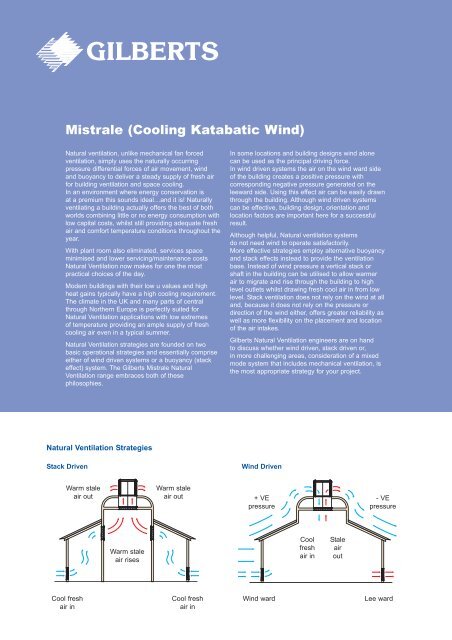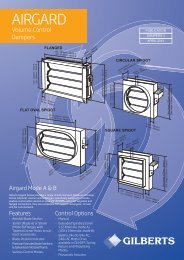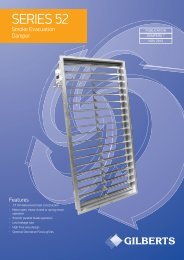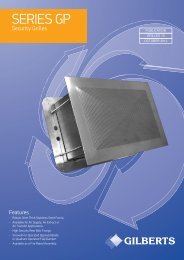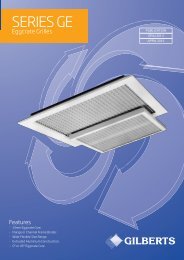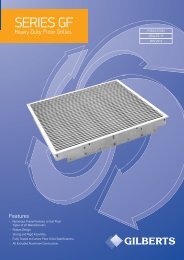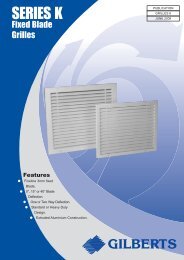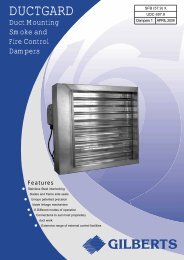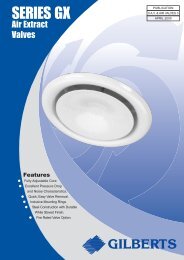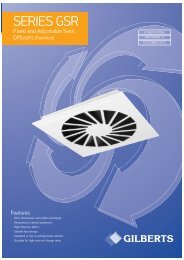NATURAL VENTILATION SYSTEM The Complete Solution - Gilberts ...
NATURAL VENTILATION SYSTEM The Complete Solution - Gilberts ...
NATURAL VENTILATION SYSTEM The Complete Solution - Gilberts ...
Create successful ePaper yourself
Turn your PDF publications into a flip-book with our unique Google optimized e-Paper software.
Mistrale (Cooling Katabatic Wind)Natural ventilation, unlike mechanical fan forcedventilation, simply uses the naturally occurringpressure differential forces of air movement, windand buoyancy to deliver a steady supply of fresh airfor building ventilation and space cooling.In an environment where energy conservation isat a premium this sounds idealand it is! Naturallyventilating a building actually offers the best of bothworlds combining little or no energy consumption withlow capital costs, whilst still providing adequate freshair and comfort temperature conditions throughout theyear.With plant room also eliminated, services spaceminimised and lower servicing/maintenance costsNatural Ventilation now makes for one the mostpractical choices of the day.Modern buildings with their low u values and highheat gains typically have a high cooling requirement.<strong>The</strong> climate in the UK and many parts of centralthrough Northern Europe is perfectly suited forNatural Ventilation applications with low extremesof temperature providing an ample supply of freshcooling air even in a typical summer.Natural Ventilation strategies are founded on twobasic operational strategies and essentially compriseeither of wind driven systems or a buoyancy (stackeffect) system. <strong>The</strong> <strong>Gilberts</strong> Mistrale NaturalVentilation range embraces both of thesephilosophies.In some locations and building designs wind alonecan be used as the principal driving force.In wind driven systems the air on the wind ward sideof the building creates a positive pressure withcorresponding negative pressure generated on theleeward side. Using this effect air can be easily drawnthrough the building. Although wind driven systemscan be effective, building design, orientation andlocation factors are important here for a successfulresult.Although helpful, Natural ventilation systemsdo not need wind to operate satisfactorily.More effective strategies employ alternative buoyancyand stack effects instead to provide the ventilationbase. Instead of wind pressure a vertical stack orshaft in the building can be utilised to allow warmerair to migrate and rise through the building to highlevel outlets whilst drawing fresh cool air in from lowlevel. Stack ventilation does not rely on the wind at alland, because it does not rely on the pressure ordirection of the wind either, offers greater reliability aswell as more flexibility on the placement and locationof the air intakes.<strong>Gilberts</strong> Natural Ventilation engineers are on handto discuss whether wind driven, stack driven or,in more challenging areas, consideration of a mixedmode system that includes mechanical ventilation, isthe most appropriate strategy for your project.Natural Ventilation StrategiesStack DrivenWind DrivenWarm staleair outWarm staleair out+ VEpressure- VEpressureWarm staleair risesCoolfreshair inStaleairoutCool freshair inCool freshair inWind wardLee ward


